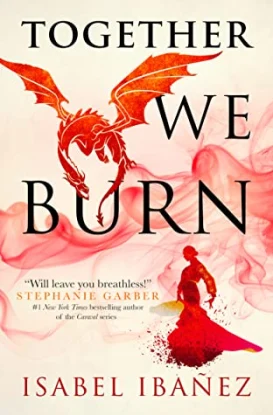Together We Burn, by Isabel Ibañez
23 Sept 2022The Book

Synopsis:
An ancient city plagued by dragons. A flamenco dancer determined to save her ancestral home. A dragon hunter refusing to teach her his ways. They don’t want each other, but they need each other, and without him her world will burn.
Eighteen-year-old Zarela Zalvidar is a talented flamenco dancer and daughter of the most famous Dragonador in Hispalia. People come for miles to see him fight in their arena, which will one day be hers.
But disaster strikes during their five hundredth anniversary show, and in the carnage, Zarela’s father is horribly injured. Facing punishment from the Dragon Guild, Zarela must keep the arena—her ancestral home and inheritance —safe from their greedy hands. She has no choice but to take her father’s place as the next Dragonador. When the infuriatingly handsome dragon hunter, Arturo Díaz de Montserrat, withholds his help, she refuses to take no for an answer.
But even if he agrees, there’s someone out to ruin the Zalvidar family, and Zarela will have to do whatever it takes in order to prevent the Dragon Guild from taking away her birthright.
My Review
Together We Burn is the second novel from the Florida writer Isabel Ibañez. It features a ton of cool things that made me want to read and review it as dragons, mystery, and it is set in a fantasy world based in Spain and most in concrete in Andalusia. So with all these elements in mind, and as somebody who has been living for more than eight years in the city used as inspiration (Seville), let’s dive into the review.
What we are going to follow is the story of Zarela Zaldivar, the daughter of two famous parents, being her mother the most cherished flamenco dancer in Hispalia (prior to her death), and her father, the most famous dragonador. Now with her only father, they run one of the most renowned arenas in Santivilla, La Giralda (where there are spectacles of dragon-fighting and flamenco); all of this changes after during the five hundred years anniversary spectacle something goes wrong, dragons are freed, causing damages and death, and hurting Zarela’s father, letting him unable to be back to the arena. To add salt to the wound, the next morning, the rest of the dragons they kept are freed, and the last tamer of the family gets assassinated. With all these elements, Zarela will have to take charge of the destiny of the family, while at the same time trying to discover who was behind the attack. With these elements, Isabel Ibañez has the perfect base to write a great story that I enjoyed from the start to the end, with many aspects I would like to comment on.
Let’s start with worldbuilding, as it is probably the aspect that touches the nearest me. The world on Together We Burn, Hispalia, is based on the Spanish culture, and, due to casually, this novel is centered around Santivilla, which is a fictional city inspired by Seville, where I have been living for near to nine years. While you are reading you can see a ton of small details that shows the hard work that Ibañez did research for making it closer to the original culture (and let me add, it’s something I’m grateful for). There are plenty of small details reflecting such as the food (particularly, I would like to point at one, the toasted almonds, which are a really distinctive element of Feria de Abril), the fact that the Zaldivar’s arena is called La Giralda, the existence of a centric tower called la Giralda, making the most important newspaper El Correo (it’s also a classic of the real city). Taking also a distinctive element of Andalusia as it is a flamenco is always risky, but she included it as one of the angular points in the novel with the deserved respect.
Now, let’s go to the point I find more interesting, but which could also spark more discussions, as it is dragon-fighting. It’s not a secret that it is inspired by bullfighting, mimicking this controversial tradition that has perdured until our days but I would say that with its structure, this dragon-fighting is closer to what we call corrida de rejones (I think there isn’t a specific English term for this, but basically would be summarized in that the bullfighting is done on a horse and with a three-part structure, which is different to the four-part structure of classical bullfighting). As in real life, dragon-fighting is kept by the force of tradition despite the number of voices claiming their suppression, and this also drives popular protest against it; we actually can see a really good way to treat the debate in Together We Burn, with all the care and respect it deserves.
Another aspect of the world that is really interesting, but which I felt could have been better developed is the Gremio structure over the different works, and how they keep an iron control over who is allowed to do a job. It is true that we get in close touch with Gremio de Dragonadores due to the problems that arise after the spectacle sabotage, but outside of that, the rest of Gremios’ presence is basically kept to the bare minimum. Magic also appears as part of the world, but it is only touched due to the magical nature of dragons and how their body parts can be used.
Characters are well developed, being Zarela the most important, as she’s going to remain the main character and the narrator for the whole story (Ibañez uses a 1st POV as the narrator which won’t change for the rest of the novel). Some special mention is deserved by Arturo, a tamer and former dragon fighter, who becomes the romantic interest of Zarela, and also the mentor who will teach her how to dragon fight in a desperate attempt to keep La Giralda afloat. An important theme is her family, and there’s also a point where Ibañez’s writing shines, as it feels realistic and natural.
Let’s stop to talk about an aspect, that personally for me it’s not problematic per se (Spanish is my mother language), but which I found weird and kinda out of point during the whole novel. While I can understand the idea behind mixing Spanish and English during this novel, especially during the dialogue between certain characters, it feels like a bad addition, because using entire sentences in Spanish can become a headache for readers who don’t have any knowledge of this language. Also, as somebody born and raised in Spain, it feels antinatural reading these kinds of characters mixing languages, when especially in the South of Spain this is really rare, being this something that for me sounds more like a Hispanic-American way to speak. I think I can understand the idea behind this stylistic proposal, but it lands far from what it pretended, in my opinion.
Despite this, I really enjoyed Together We Burn, as it fills a niche that I spent years looking for. There is not so much fantasy taking root in Spanish culture, so this book felt like a breath of fresh air. I would totally recommend this book to readers who enjoy a fast-paced adventure, with plenty of elements to explore; and honestly, I would like to see Isabel Ibañez trying to come back to Hispalia for future novels.
The Author/s

Isabel Ibañez
Isabel Ibañez was born in Boca Raton, Florida, and is the proud daughter of two Bolivian immigrants. A true word nerd, she received her degree in creative writing and has been a Pitch Wars mentor for three years. Isabel is an avid movie-goer and loves hosting family and friends around the dinner table. She currently lives in Winter Park, Florida, with her husband, their adorable dog, and a serious collection of books.
